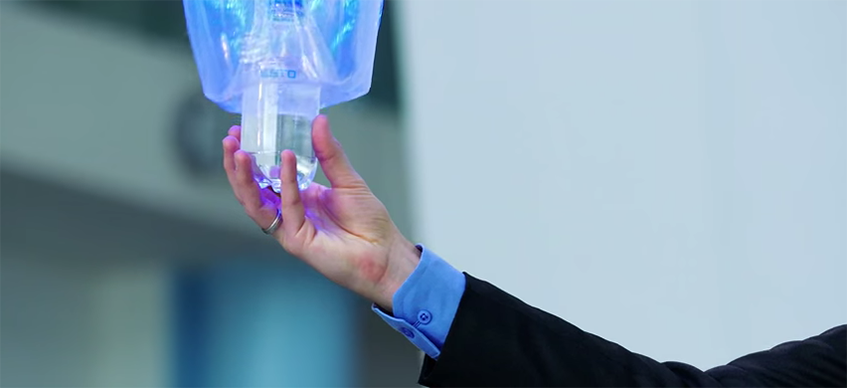Imagine a world where your pizza or package is slurped up and delivered to you by a big, flying helium drone. Or don’t — just watch it in action.
Inspired by nature
Festo is a worldwide company that spends its days trying to innovate and improve the technology used in manufacturing and automation processes. Much of their work is complicated, mechanical mastery that is often inspired by the designs that nature seems to execute so simply and perfectly.
Their flying helium drone is true to their mission. It combines two previous innovations: the eMotionSphere and the FlexShapeGripper. The end product is a flying, hovering ball of helium that can suck up objects and bring them directly to you.
Helium drone balloon
The balloon itself is 54 inches in diameter when fully inflated with helium. In the air, it weighs the same as 50 paperclips.
An ultra-light carbon fiber surrounds the balloon and houses eight propellers, which allow the helium drone to fly in any direction or simply hover in place.
Onboard cameras monitor the surroundings so that the helium drone can actually react to objects or obstacles within its environment and adjust its path.
Gripper tongue
The gripper of the helium drone was inspired by chameleons. A chameleon’s actually grabs insects using a unique, suction-like tube at the end of its stretchy tongue. The gripper on the helium drone works the same way and believe it or not, it’s as effective as the human hand.
It’s strong enough to pick up coffee mugs by the handle yet delicate enough to grab and hold a light bulb. Where it may trump a human hand is in its ability to maintain gripping strength indefinitely. Once an object is in its grip, it can hold it forever without requiring any additional power.
The FlexShapeGripper uses silicon, water, air, and pressure. Pressurized chambers are pumped with air and water. Depending on what the object is, the amounts of air and water pumped into the chambers vary, so that the gripper can adapt to the shape and size of the object it’s picking up.
A camera inside the gripper acts like an eyeball, alerting the system to the size and shape of the object so it knows how to go about picking it up.
And since the rotors surrounding the helium drone allow it to fly and rotate in any direction, the gripper can pick something up and drop it off on the side or even flip upside-down.

Capabilities & limitations of the helium drone
The helium drone does not require a pilot; it navigates using a combination of its onboard camera and GPS. However, the current technology relies on a sophisticated indoor system of external sensors and cameras with which it communicates with in order to plan its route.
The helium drone has six onboard batteries that are rechargeable, but allow for a somewhat limited flight time of 40 minutes; and that’s when the gripper is empty. Depending on the frequency and weight of retrieved items, flight time per charge can be dramatically shorter.
One limitation of the gripper is that is currently designed to pick up smaller, lighter objects. There’s no word on if and when it can deliver your extra large pizza.
The future of the helium drone
Festo’s vision for the helium drone is to act as a delivery servant within large companies and factories, eliminating the need to have to get up from a meeting to get a coffee or go to the ground to fetch a tool to complete a high elevation construction project.
In the future, the helium drone should be able to use GPS and its onboard cameras to fly outside just as autonomously and accurately as it does indoors.
Check out a video of this incredible technology in action:
Source: Festo


